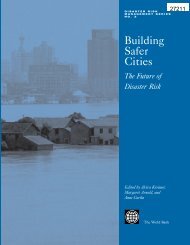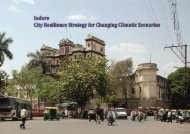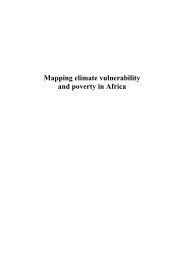Climate Change and Local Level Disaster Risk Reduction Planning ...
Climate Change and Local Level Disaster Risk Reduction Planning ...
Climate Change and Local Level Disaster Risk Reduction Planning ...
You also want an ePaper? Increase the reach of your titles
YUMPU automatically turns print PDFs into web optimized ePapers that Google loves.
identification of what is called ‘coupling points’ is necessary. The Figure 7 depicts various stages<br />
involved in disaster risk management <strong>and</strong> ‘coupling points’ where climate change may have<br />
influence. It can be seen that almost all stages of disaster risk management cycle could be targeted<br />
to mainstream the climate change concerns.<br />
The discussants could ask certain questions in order to identify the above coupling points. The<br />
Table 2 presents various questions one could ask while identifying the coupling points. These<br />
questions enable various functionaries to identify climate change as a factor while planning for<br />
interventions. Once local impacts are identified <strong>and</strong> all the stakeholders agree upon them, it is<br />
time to classify them according to short-term <strong>and</strong> long-term impacts <strong>and</strong> identify appropriate risk<br />
reduction measures. Consultation process could also include identification of resources required<br />
such as capacity building needed to h<strong>and</strong>le the new interventions, finances required <strong>and</strong> its source<br />
<strong>and</strong> threats due to the decisions made under uncertainty. It is important for the so drafted<br />
strategy to explicitly acknowledge the uncertainty with which the decisions were made.<br />
3. Factors to be considered for mainstreaming<br />
In this section, we discussed various factors to be considered for achieving satisfactory realization<br />
of the above presented scheme. We divided the factors into uncertainty in climate change risk,<br />
capacity limitations, perception <strong>and</strong> awareness limitations, <strong>and</strong> economic limitations.<br />
3.1. Uncertainty in climate change risk<br />
One of the important limitations in implementing the above suggested scheme is uncertainty in<br />
projected climate impacts itself. Global Circulation Models (GCMs) are considered to be too<br />
course resolution <strong>and</strong> hence are not sufficient for decision making for adaptation (Prudhomme et<br />
al, 2003). Hence, employment of techniques such as regional circulation models has come into<br />
vogue. However, there are limitations with downscaling too (Wilby, 2002). One of the major<br />
bottlenecks limiting decision making based on these techniques is the unaddressed uncertainty of<br />
climate change (Tol, 2003; Webster et al, 2003; Forest et al, 2004; Lempert et al, 2004; Trenberth,<br />
14<br />
Table 2









